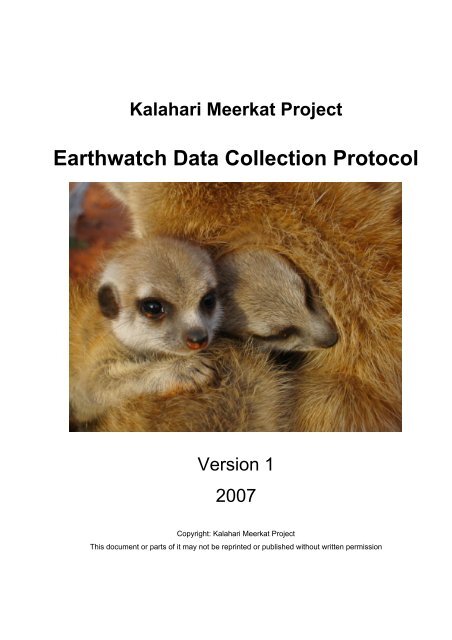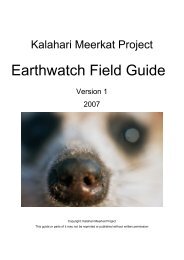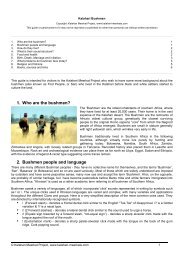Earthwatch Data Collection Protocol - The Kalahari Meerkat Project
Earthwatch Data Collection Protocol - The Kalahari Meerkat Project
Earthwatch Data Collection Protocol - The Kalahari Meerkat Project
Create successful ePaper yourself
Turn your PDF publications into a flip-book with our unique Google optimized e-Paper software.
<strong>Kalahari</strong> <strong>Meerkat</strong> <strong>Project</strong><strong>Earthwatch</strong> <strong>Data</strong> <strong>Collection</strong> <strong>Protocol</strong>Version 12007Copyright: <strong>Kalahari</strong> <strong>Meerkat</strong> <strong>Project</strong>This document or parts of it may not be reprinted or published without written permission
TABLE OF CONTENTS1. GENERAL INTRODUCTION.................................................................................................... 32. THE STUDY POPULATION..................................................................................................... 43. GENERAL DATA COLLECTION PROTOCOLS ...................................................................... 43.1. LIFE HISTORY DATA................................................................................................. 43.2. SUPPLEMENTAL ADLIB DATA ................................................................................. 43.3. WEIGHTS................................................................................................................... 54. EARTHWATCH DATA COLLECTION PROTOCOLS .............................................................. 74.1 TRACKING SESSIONS............................................................................................... 74.2 FORAGING FOCAL PROTOCOL ............................................................................... 84.3 DRONGO SCANS AND FOCALS ............................................................................... 8APPENDIX I. SAFETY GUIDELINES.......................................................................................... 91. EMERGENCIES................................................................................................................ 92. SAFETY AROUND THE HOUSE...................................................................................... 93. SAFETY IN THE FIELD .................................................................................................... 93.1. Getting lost ................................................................................................................. 93.2. Hypothermia ............................................................................................................. 103.3. Hyperthermia, Heat-stroke, sunburn, dehydration .................................................... 103.4. Game........................................................................................................................ 113.7. Snakes...................................................................................................................... 12© <strong>Kalahari</strong> <strong>Meerkat</strong> <strong>Project</strong>, www.kalahari-meerkats.com 2
2. THE STUDY POPULATION<strong>The</strong> <strong>Meerkat</strong> <strong>Project</strong> works with a number of very well habituated meerkat groups. It’s possibleto walk with these groups while they are foraging, and to weigh almost all of the members.<strong>The</strong>se focal groups allow us to collect very detailed behavioural data. <strong>The</strong>re are currently 14focal groups at the KRR study site (composed of approximately 225 meerkats). Five habituatedgroups reside exclusively within the boundaries of the KRR, while the ranges of the other studygroups extend over a number of neighbouring farms, primarily Rus en Vrede, <strong>The</strong> Heights, andLeerdoos. Wherever possible, <strong>Earthwatch</strong> volunteers will work exclusively on groups that staywithin the reserve boundaries, these are currently, Lazuli, Moomins, Whiskers, Young Ones,Commandos and where possible Elveera and Gattaca..3. GENERAL DATA COLLECTION PROTOCOLS3.1. LIFE HISTORY DATA<strong>The</strong> project aims to keep accurate life history records for each animal in the population. Births,deaths, pregnancies, the onset and conclusion of lactation and oestrus, changes in dominancestatus, and short term absence from a group (roving for mating partners or evicted from group)are regarded as important data. With the aid of a group mark identification sheet, you will assistyour <strong>Meerkat</strong> <strong>Project</strong> partner in the following:• Help to establish group composition (essentially a sort of roll-call) at the start and end ofeach session, and at regular intervals during the session itself. Animals often come andgo, and it is necessary to pay close attention to this.• Take note of any signs of pregnancy (abdominal swelling), lactation (prominent nipples),dominance interactions, aggressive encounters, etc.• Keep a sharp look out for injuries or signs of disease.3.2. SUPPLEMENTAL ADLIB DATAOne of the main data types routinely collected by the <strong>Meerkat</strong> <strong>Project</strong> is adlib data. Thisessentially comprises recording any noteworthy behaviour or activity (which is pretty muchanything other than normal foraging behaviour) as and when it is seen to occur. <strong>Meerkat</strong> <strong>Project</strong>researchers are trained to recognise and interpret a wide range of behaviours, and to record© <strong>Kalahari</strong> <strong>Meerkat</strong> <strong>Project</strong>, www.kalahari-meerkats.com 4
- Morning weight (MW) - collected first thing in the morning, if the weight is collected 15minutes after the meerkat group has left the sleeping burrow record it as a morningweight interrupted (MWI)- Lunch-time weight (LW) - collected at the end of a morning’s observation period.- Evening weights (EW) are collected once the group has returned to their sleepingburrow for the night or just before they return.Time weighed: enter the time each individual’s weight is taken. For morning and eveningweights, record the same time for all the animals (the mid-point of the weighing session).However, it is essential that you record individual times for lunch weights (LW) and formorning weights interrupted (MWI).Missed individuals:If you don’t get an individual’s weight, it is worth making a note why:AO = absent;Ref = refused to be weighed;BO = down the burrow;BS = babysitter;© <strong>Kalahari</strong> <strong>Meerkat</strong> <strong>Project</strong>, www.kalahari-meerkats.com 6
4. EARTHWATCH DATA COLLECTION PROTOCOLS<strong>The</strong> primary data focus will be the collection of foraging focals during the morning meerkatsessions and the collection of meerkat/drongo interaction data in the evenings. Group trackingdata shall be collected at the same time.4.1 TRACKING SESSIONSWhat factors influence territory use?Investigator: <strong>Kalahari</strong> <strong>Meerkat</strong> <strong>Project</strong>Background:<strong>Meerkat</strong> groups occupy territories of around 3-4km 2 , comprising a number of sleeping burrows and a network ofemergency refuges or “boltholes”. <strong>The</strong>se territories are far from uniform. Food resources, cover from predatorsand proximity to neighbours vary considerably, on spatial and temporal scales, both within and among territories.<strong>The</strong> choice of foraging route is therefore an important factor affecting the fitness of each individual in the group.However, amongst the individual group members there may be conflict of interest over which route is best. Forinstance, hungry individuals would obviously be most interested in food-rich areas of the territory, whilereproductively active subordinate males and females may prefer to spend time in the more remote areas of theterritory, where encounters with potential mates are more likely. Mothers with young pups may prefer areas wellaway from hostile neighbours, or areas with better cover to provide protection against predators.Questions:• Do meerkats use a limited repertoire of foraging routes?o Are these routes influenced by (a) predation rate?(b) breeding prospects?• Do meerkats always use the same route between two given bolt-holes?o Is that route (a) the shortest?(b) the one offering the best foraging?(c) the safest (i.e. high density of nearby bolt-holes)?• How are territory boundaries established?• How do meerkats know and orientate themselves within their home range?Methods:For the time being, we will simply gather information on the groups movements each day. Positions will berecorded using handheld GPS units (GPS=Global Positioning System) and later plotted to reveal the foragingroute followed during the session.© <strong>Kalahari</strong> <strong>Meerkat</strong> <strong>Project</strong>, www.kalahari-meerkats.com 7
4.2 FORAGING FOCAL PROTOCOLDevelopment of foraging skills, Foraging Strategies,and the consequences of individual fitness difference.Investigator: <strong>Kalahari</strong> <strong>Meerkat</strong> <strong>Project</strong>Background:<strong>Meerkat</strong>s must devote the majority of each day to foraging. Invertebrate prey, which comprise the bulk oftheir diet, must usually be excavated from below the sand surface. <strong>The</strong> best foragers can find more foodand expend little energy for each unit of food consumed, which allows them to devote greater energyreserves to growth and the maintenance of a better body condition. Good foragers can also afford tospend more time avoiding predators, improving social ties, helping relatives to breed, or pursuing theirown opportunities to reproduce – activities that may have very important consequences for their fitness.So who are the best foragers in a meerkat group?Questions:- Which meerkats are the most efficient foragers?- - How do meerkats develop their ability to find food, how does this change with hole depth- - - How does good foraging ability influence individual reproductive strategy- - - - How do individuals alter their foraging strategies in response to ability and food availabilityMethods:Individual foragers will be followed (“focalled”) for 15-min periods, during which time all significantdigging bouts will be recorded). Information will also be taken on the size of hole, any prey itemsacquired and how often the meerkat is ‘vigilent’ during a focal4.3 DRONGO SCANS AND FOCALSTo what extent do drongos rely on kleptoparasitisingmeerkats to meet their dietary requirements?Investigator: Tom Flower / <strong>Kalahari</strong> <strong>Meerkat</strong> <strong>Project</strong>Background:Fork-tailed drongos (Dicrurus adsimilis) are adept opportunists that commonly follow foraging groups ofbirds and mammals to snap up any insects that are disturbed by their activities. However, it is alsobelieved that they contrive to steal food items from animals they follow, termed Kleptoparasitism.Drongos often attempt to steal unearthed prey from unsuspecting meerkats, and will even employ falsealarm calls to trick meerkats into abandoning their quarry. In order to study this fascinating interaction wemust first observe drongos in association with meerkat groups to ascertain the nature of drongo meerkatbehavioural interaction and the roll of drongo calls.Questions:- How do drongos find food when they follow meerkats, are they kleptoparasitising the meerkats- What is the response of meerkats to calls made by drongos and what are drongo’s calling for.Methods:Observers will conduct scans at 10-minute intervals to note the presence or absence of drongos with thegroup. In addition, when drongos are noted as being present with a group, the observer will focal onedrongo at every alternate scan (i.e. do not focal drongos for more than 10 minutes consecutively), themanner in which all prey items were acquired and what context drongo’s emit calls in.© <strong>Kalahari</strong> <strong>Meerkat</strong> <strong>Project</strong>, www.kalahari-meerkats.com 8
APPENDIX I. SAFETY GUIDELINES1. EMERGENCIESFor your own safety…..- ensure you have valid health/travel insurance fro the duration of your stay, and fill in your andyour next of kin’s (or emergency contact) details on the emergency clipboard so that they areaccessible in the event of an accident- familiarise yourself with our emergency procedures and the locations of First Aid kits, fireextinguishers, fire-fighting equipment and emergency telephone numbers. Don’t rely on otherpeople knowing where things are and what to do; you may be the only person around whenan emergency happens.- always carry your emergency first-aid kit when in the field- always wear closed shoes after dark and in the field2. SAFETY AROUND THE HOUSE- take care when handling electrical sockets, plugs, adapters, etc.- avoid walking around the house and garden in bare feet, always wear closed shoes whenin the field or outside at night. Cape Cobras have been seen in the garden several times, andscorpions often make their way into the house. You should always switch on the light or carrya torch when going to the bathroom in the night.- when handling boxes, furniture, etc. (particularly in the storeroom, garage or on the veranda),check for spiders first.- when using candles (i.e. when there is a power failure), do not leave them unattended andtake great care that they cannot make contact with anything flammable, particularly whenthey burn down low.- Smoking indoors is prohibited. <strong>The</strong> rondavels have thatched roofs and as such represent asignificant fire hazard. Each rondavel is fitted with a smoke detector to warn of fire, butsmoking indoors will also trigger their alarms.3. SAFETY IN THE FIELD3.1. Getting lostFamiliarise yourself with the layout of roads, fences and the river. Always carry a GPS, radio,torch and matches. Stay aware of where you are when walking with the meerkats (i.e. note the© <strong>Kalahari</strong> <strong>Meerkat</strong> <strong>Project</strong>, www.kalahari-meerkats.com 9
number of dunes you’ve crossed, what fences you’ve climbed, any land marks or burrowmarkersthat you’ve passed, etc).Once you are lost, don’t panic. Use your radio to call for assistance, we will then come and findyou. If you do not have a radio, or if the radio repeater station has lost power someone will comelooking for you when you do not return at the expected time. Stay where you are and we will findyou, the further you move the harder you will be to find. You can try climbing a nearby high duneor tree to see if you can see the road, wind-pump, river, fence or power lines. It may be possibleto follow your footprints back the way you’ve come. Don’t risk contracting heat-stroke; if it’s veryhot, just sit in the shade and wait for someone to find you. Similarly, if you’re still lost after acouple of hours, just sit down and listen for people calling you and watch for lights if it’s dark.3.2. HypothermiaIn winter the early morning and evening air can be very cold – especially if accompanied bywind. Always ensure that you have appropriate clothing (e.g. warm hat, gloves). A spare jumperis useful at all times just in case you stay longer in the filed than planned. Reduce heat loss bybreathing through a scarf or balaclava and find shelter from the wind if possible, but do not sit upagainst cold objects as they will simply speed up heat loss. <strong>The</strong> onset of hypothermia is markedby violent shivering, clumsiness, confusion, or sleepiness, and a weakened pulse or breathing. Ahypothermic person will appear bluish and their pupils will be dilated. If these symptoms areobserved, call fro help. Note that your emergency kits contain foil blankets which provideexcellent thermal insulation in emergencies.3.3. Hyperthermia, Heat-stroke, sunburn, dehydration<strong>The</strong> <strong>Kalahari</strong> is hot in summer! During your first few weeks on the Farm, always wear plenty ofsunscreen. Beware of doing anything energetic in the middle of the day. Never go out in thefield without a hat and water between September and April, and make a conscious effort to drinkplenty of water throughout the day. Remember that you can suffer dehydration without feelingthirsty. Symptoms include nausea, headache, dizziness, light-headedness and a restless feelingof non-specific discomfit and ill-ease.If you are feeling badly discomfited by the heat, rest in the shade for a few minutes until you feelbetter. If you stop sweating, the situation is serious, and you must cool yourself downimmediately. Retreat to the shade/house, douse yourself with cold water or submerge yourself ina cold bath or in the pool, and drink plenty of cold drinks.© <strong>Kalahari</strong> <strong>Meerkat</strong> <strong>Project</strong>, www.kalahari-meerkats.com 10
3.4. GameLarge game such as Gemsbok, wildebeest or hartebeest can potentially do serious harm withtheir hooves and horns, though they are not normal aggressive and will usually keep theirdistance. Treat them with respect, maintain a safe distance, and avoid panicking them (i.e.trapping them in a corner of a fenced camp).<strong>The</strong> farms in our area stock ostriches as well as cattle, sheep and goats. Most of these birds areshy of people and run away when they see you (take care not to panic these birds).Occasionally, however, a breeding male (recognisable by the red flush on the front of his legs)becomes aggressive. If you are working in an area where there is a known aggressive ostrich,keep an eye open for the birds at all times (the meerkats usually give a rolling alarm call whenthey see an ostrich approaching). At regular intervals check your surroundings for climbabletrees, large piles of dead timber (into which you can clamber) and fences, so that you alwaysknow where you can escape if an ostrich attacks. Try to avoid loitering in places that have norefuges. If you see an ostrich running toward you, immediately retreat beyond its reach.DISCRETION IS THE BETTER PART OF VALOUR.If you cannot escape the bird, you can try throwing stones or timber at it, or hitting it with a heavypiece of wood (aim for the head, neck or legs, not the body). Some people recommend lyingdown on the ground (face first, covering your head). Bear in mind that ostriches are just as agileas you are, so dodging around trees and bushes isn’t a feasible strategy. <strong>The</strong> bird will try to kickyou (ostriches kick forward). Don’t panic. A number of people on the <strong>Project</strong> have been kickedby ostriches and they’ve suffered no worse than torn clothes and minor bruises. <strong>The</strong> ostrichnormally struts off to display after a couple of attacks.3.5. Spiders<strong>The</strong>re are three spider species you are likely to come in contact with. <strong>The</strong> black and brownwidow spiders, which are web dwellers and the sac spider, which is a active forager. You canrecognise Black Widow Spiders by their pea-shaped abdomen, narrow thorax and red hourglasspattern on both the ventral (stomach) and dorsal (back) surfaces of the abdomen. If you arebitten (bites are not fatal, except to small children), apply a pressure bandage (as for cobra bite,Error! Bookmark not defined.) and go to a local hospital for treatment. Brown Widow Spidersare similar in appearance but have the red pattern on their ventral surface only. <strong>The</strong>ir bite ispainful but does not require hospitalisation. <strong>The</strong> sac spider can be recognised by their creambody and pronounced black fangs. <strong>The</strong>y do not spin webs but instead make a silky sac in thefolds of materials or cracks of walls. <strong>The</strong> bite is not deadly, but may form a ulcerative wound due© <strong>Kalahari</strong> <strong>Meerkat</strong> <strong>Project</strong>, www.kalahari-meerkats.com 11
to the cytotoxic venom. Treatment involves oral antibiotics to prevent secondary infection andpainkillers that can be issued at the local clinic.3.6. ScorpionsScorpions are active at night (although you’ll see meerkats eating them by day) so don’t walkaround after dark without closed footwear. If you see a scorpion in the house, warn other people.Four species of scorpion occur here. <strong>The</strong>re are two species of Burrowing Scorpion (Shiny andCape) who have big chelipeds (front pincers) and small tails, and two species (the CapeScorpion and the Thick-tailed Granulated Scorpion) who have small chelipeds and a large, thicktail. If you get stung by a scorpion, look closely at its tail and front pincers so you know whichspecies it is. <strong>The</strong> sting of the first two species is very painful but not dangerous. Take painkillersand apply an ice pack to reduce the pain. <strong>The</strong> sting of the second species is much more serious(can be fatal without medical treatment). Apply a pressure bandage (as for snake bite, seeError! Bookmark not defined.), take painkillers, apply an ice-pack and go to the nearesthospital straight away (ring ahead to let them know you are coming). You have several hoursbefore serious symptoms develop.3.7. SnakesWe do not see snakes particularly often, but they are out there. A number of different speciesoccur here, but the most common venomous species are the Cape Cobra (yellow withchocolate-button eyes) and the Puff Adder (short, thick, diamond-patterned and - whenthreatened - sounds like a deflating football).- use a torch when walking back from the group in the evening and pay attention to where youput your feet (finish entering data on your Psion BEFORE starting to walk back). Puff adderstend to lie cryptically on paths waiting for small rodents to stumble on them.- stomp (but not when you’re with the meerkats) so snakes will feel the vibrations and get outof your way. Puff adders don’t tend to move away, but will puff (a rushing air sound) if theyknow you’re about to step on them.- boots are considerably safer than sandals and closed shoes (never sandals) should alwaysbe worn in the field- stand well back when the meerkats mob a snake- do not touch or handle ANY snake (even if it appears dead), as species identification isdifficult, colour can vary greatly, and some species “play dead”.- do not put up your hand down holes or under fallen timber© <strong>Kalahari</strong> <strong>Meerkat</strong> <strong>Project</strong>, www.kalahari-meerkats.com 12
- do not walk around outside at night without a torch (this includes the garden)If you get bitten, don’t panic. Make sure you know what the snake looks like (for identificationpurposes) but don’t try to catch or kill it.Puff adder biteIf you are bitten by a puff adder, DO NOT apply a pressure bandage or tourniquet, or cut thewound; all these things will make things worse. Puff adder venom is cytotoxic: it does not movearound the body and is slow acting, but it breaks down the cells at the site of the bite. Stay calm;adults very rarely die from puff adder bites. Ideally stay where you are and radio for help. Keepwarm (use a blanket or a coat even if you don’t feel at all cold) and drink lots of water, to preventshock from setting in. Phone the hospital for their advice and to let them know you are coming,then get there as quickly as possible.Cobra biteIf the snake was a cape cobra, you should immediately apply a pressure bandage andimmobilise the limb. Cobra venom is neurotoxic; it travels around the body via the lymphaticsystem and affects your nervous system. Fluid is pushed around the lymphatic system by thepressure of moving muscles and joints. A firm bandage slows the flow of the lymph, as doesimmobilising the limb’s muscles and joints. (A tourniquet is no use because it cuts the blood flow(which can cause gangrene) not the flow of lymph.)Ideally, use a broad elastic bandage, or you can make do with strips of torn up clothing. Youshould quickly bandage the whole limb as firmly as you would for a sprain, starting at the top ofthe limb (where it joins the body) and working downwards towards the bite. Mark the site of thebite on the outside of the bandage. (If, when you press the extremity of the bandaged limb (i.e.the fingers or toes), the press-mark stays white (i.e. it does not go pink again as the bloodreturns), the bandage is too tight. DO NOT REMOVE IT (not until you are with a doctor at thehospital), but you can cut every second turn of the bandage, 2/3rds of the way through thebandage’s width, to loosen it.) Ideally, the limb should be splinted so you can’t move it. (Use asturdy branch, plank or aerial, lie it along the bandaged limb, and bind it on, above and beloweach joint. It should be positioned so that the joints can’t bend.)If the bite is not on a limb, use your hand to press firmly on the area around the bite.© <strong>Kalahari</strong> <strong>Meerkat</strong> <strong>Project</strong>, www.kalahari-meerkats.com 13
If you are with someone else, you should lie down and relax while they go or radio for help (yourlimb must be bandaged, however). Make sure that they and/or you take careful note of exactlywhere you are located. Someone should be requested to go as rapidly as possible to the nearestphone and ring for a helicopter ambulance, and phone the hospital to check they’reprepared for your arrival (i.e. they have the appropriate anti-venom).If you are alone, bandage your limb firmly, and then make your way to help (e.g. go to thenearest person who can then go to the phone, etc.) as quickly as possible. Try not to use thebitten limb (it will help to splint it) because it’s muscle movement that pushes the poison awayfrom the site of the bite. Once you’ve reached help, keep warm (use a jacket or blanket even ifyou don’t feel cold) and drinks lots of water, to prevent shock. Remember that venomous snakesfrequently bite without injecting venom (they don’t want to waste it on you!).© <strong>Kalahari</strong> <strong>Meerkat</strong> <strong>Project</strong>, www.kalahari-meerkats.com 14





